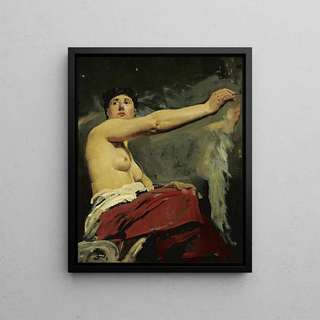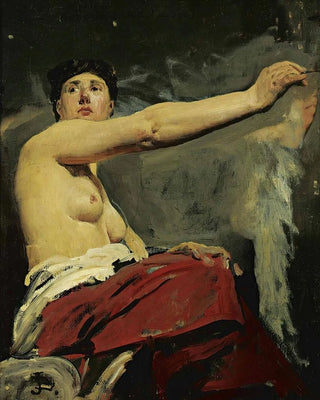Art print | Study for the central figure of the ceiling of the Legion of Honor Palace - Jean-Paul Laurens


View from behind

Frame (optional)
The artwork "Study for the central figure of the ceiling of the Palais de la Légion d'honneur" by Jean-Paul Laurens is a masterpiece that embodies the refinement and grandeur of 19th-century French academic art. This study, created for the decoration of one of Paris's most iconic locations, immerses us in a universe where history and mythology intertwine. Laurens, through his undeniable talent, manages to capture the very essence of heroism and virtue, themes dear to his era. Contemplating this piece, the viewer is immediately transported to a world where beauty and symbolism meet, awakening a fascination with epic tales that have shaped national identity.
Style and uniqueness of the work
The uniqueness of this study lies in Laurens's technical mastery, which combines a keen sense of composition with a palette of delicately nuanced colors. The figures, in motion, seem to come alive under the attentive gaze of the viewer. Each character, carefully positioned, tells a story, and the interaction between them evokes a dynamic that transcends the frame of the canvas. The treatment of the drapery, with an almost airy lightness, demonstrates a virtuosity reminiscent of the great masters of the Renaissance. Laurens, as a true visual storyteller, manages to infuse an atmosphere of grandeur and majesty, while maintaining an intimacy that invites close observation of the details. This work is not merely a preparatory study; it is a true ode to the art of pictorial storytelling.
The artist and his influence
Jean-Paul Laurens, an emblematic figure of the French school, established himself as a master of historical painting. His works, often inspired by significant historical events and mythological figures, reflect a deep reflection on the role of art in society. Laurens was influenced by the major artistic currents of his time, while developing a personal style that is uniquely his own. His commitment to academic tradition, combined with his desire for innovation, allowed him to

Matte finish

View from behind

Frame (optional)
The artwork "Study for the central figure of the ceiling of the Palais de la Légion d'honneur" by Jean-Paul Laurens is a masterpiece that embodies the refinement and grandeur of 19th-century French academic art. This study, created for the decoration of one of Paris's most iconic locations, immerses us in a universe where history and mythology intertwine. Laurens, through his undeniable talent, manages to capture the very essence of heroism and virtue, themes dear to his era. Contemplating this piece, the viewer is immediately transported to a world where beauty and symbolism meet, awakening a fascination with epic tales that have shaped national identity.
Style and uniqueness of the work
The uniqueness of this study lies in Laurens's technical mastery, which combines a keen sense of composition with a palette of delicately nuanced colors. The figures, in motion, seem to come alive under the attentive gaze of the viewer. Each character, carefully positioned, tells a story, and the interaction between them evokes a dynamic that transcends the frame of the canvas. The treatment of the drapery, with an almost airy lightness, demonstrates a virtuosity reminiscent of the great masters of the Renaissance. Laurens, as a true visual storyteller, manages to infuse an atmosphere of grandeur and majesty, while maintaining an intimacy that invites close observation of the details. This work is not merely a preparatory study; it is a true ode to the art of pictorial storytelling.
The artist and his influence
Jean-Paul Laurens, an emblematic figure of the French school, established himself as a master of historical painting. His works, often inspired by significant historical events and mythological figures, reflect a deep reflection on the role of art in society. Laurens was influenced by the major artistic currents of his time, while developing a personal style that is uniquely his own. His commitment to academic tradition, combined with his desire for innovation, allowed him to






